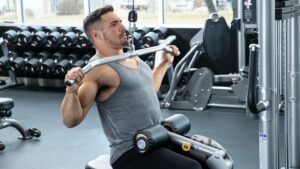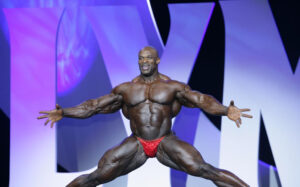Training twice a day can be grueling, exhausting, and very difficult, but there are ways to ensure you are maximizing your muscle growth and physical strength by training twice per day, especially when prepping for any upcoming show where you want to offer your best package ever.
There could be any number of reasons you train twice a day. For many sports, fitness/bodybuilding including, training twice a day is nothing unusual, for a lighter session may be matched with a more intense one. Oftentimes, for endurance sports, there’s a lift thrown in the mix as well. But some people may find they are more productive if they work out twice a day and it has become a staple in their routine. Whatever your reason may be, training twice a day can take it’s toll, and it’s important to know the proper steps to take in order to maximize growth as effectively as possible.
For those who love the gym and find two days enjoyable, that’s great and keep going. But for those bodybuilders who are in competition prep, the reason you would train twice a day is for added frequency. The more time you train effectively, the more you get out of your training and into your performance. With all this being said, it relies on you taking the best care of yourself when it comes to nutrition and recovery, so don’t be impulsive about this. It requires a well-thought-out plan of attack before success.
Let’s take a look at what training twice a day means for us and exactly what it entails. The benefits and drawbacks are good to know, as well as helpful tips and tricks that get us to where we want to be so we maximize our growth as effectively as possible.

-
What Are The Most Benefits Of Training Twice A Day?
When it comes to training twice a day, the benefit, as said before, is frequency. The more time you are in the gym, the more you get out of your training, leading to those gains we desire most. This will work to increase training volume and keep you moving as you look to accelerate not only muscle growth, physical strength BUT also performance gains and results. This offers you a way to really optimize not only your time but personal output so you don’t succumb to overtraining but still ride the fine line that all elite athletes do.
One of the most obvious benefits of two-a-day workouts is that you’re logging more activity than if you were only exercising once. Considering that a 2017 study published in the International Journal of Obesity points to time spent sedentary as a clear risk factor for coronary heart disease and increased waist circumference,1 if you can increase your daily activity, that’s a good thing.
But increasing your total daily activity isn’t the only potential benefit. Brandon Mentore, a strength and conditioning coach and sports nutritionist, points out that two-a-days are great for improving overall performance.
“Training twice in the same day can trigger accelerated muscle growth and strength gains,” Mentore says. “Training volume is an essential factor for almost all fitness goals, and training several times a day allows you to squeeze in more volume, increasing protein synthesis, metabolic capacity, and anabolic output.”
In other words, when programmed correctly, two-a-days could help you reach your goals faster. And, if implemented with safety in mind, can provide a number of benefits.
-
How About The Most Drawbacks Of Training Twice A Day?
Some potential drawbacks to training twice a day can result from a lack of care for your body in terms of supplementation, nutrition, and recovery. You can run the risk of overtraining which occurs when we don’t allow ourselves enough recovery time between sessions. As a result of that heavy load we put on by the continued stress and strain of these big lifts, it can be challenging to gauge just how far to push ourselves. Some signs of overtraining are high heart rate, fatigue, decreased appetite, and real exertion to get through even a simple workout. If we don’t take care of ourselves when it comes to training and overtraining, we also run the risk of injury which would keep us out longer than we want.
Aside from the fact that double the workouts mean double the sweaty laundry, the primary problem with two-a-days is that increased training volume puts you at greater risk for overtraining.
Exercise is considered a form of physical stress, and even though this type of stress stimulates physical adaptations that support all-around good health, adding too much at once can prove problematic.
“It can really tax your neuromuscular system,” Mentore says, “increasing your likelihood for injury, disrupting sleep patterns, suppressing your immune system, and many other symptoms if you don’t take the time to recover appropriately.”
As the adage goes, there is such a thing as too much of a good thing. So be aware of what you are doing and how your body is feeling. Don’t try to push yourself beyond what you can handle.

-
The Most Best Tips For Those Individuals Training Twice A Day
For those who enjoy training twice a day, or feel it is a necessity, here are some helpful tips to get you on your way to avoid overtraining and really tackle those grueling workouts as effectively as possible.

-
Get The Most Strategic Plan Of Training Twice A Day
Going into these training days, it is vital to have a strategic plan. You won’t be able to max bench press in the morning and then max deadlift and squat in the afternoon. This is where that careful planning comes into play and you must be diligent with how you structure your day. Something like a heavy chest day in the morning and a lighter shoulder day in the afternoon would work well. If you want to go heavy on both, try and work totally different muscle groups to not cause fatigue through overlap.

-
Get The Most Enough Fuel Of Training Twice A Day
Fuel is more than important on any day, let alone a day where you work out twice. Making sure you get adequate amounts of protein, carbs, and fats into your body will ensure a solid macronutrient balance, as well as offering you the chance at absorbing those essentials micronutrients as well (3). Take the time in between workouts to really fuel up and get the right nutrients into your body.

-
Get The Most Proper Hydration Of Training Twice A Day
We all know hydration is key and easy to neglect. Make sure you drink enough water, but also any drink that may contain electrolytes and all the good stuff you want and need most. Staying hydrated not only keeps you feeling great overall since it will work as a fatigue buster, but proper hydration can lead to a solid-fluid balance, increased muscle fuel, maintained caloric control, and will give you clarity and focus for productivity (4). Don’t sell yourself short and under hydrate, especially when training twice a day.

-
Stretch
Stretching is one of the more common things we don’t put enough effort into, or just skip completely. Stretching and finding a good routine will benefit you in all three phases of your workout: before, during, and after. Before it is great to do some dynamic stretching to really get those muscles primed and ready to go. After, when the muscles are filled with lactic acid and blood, stretching can work to eliminate toxins for decreased soreness and increase the potential for muscle fiber growth. Arguably, the best time to stretch is during your workout. Stretching in between sets expands the fascia and pulls the connective tissues and muscle apart which works to separate the muscles and provide for definition.

-
Wrapping Up
For those who train twice a day, there are important steps to take so you don’t fall victim to overtraining and excessive fatigue. As an elite athlete, you know your body and it will tell you what it needs. Continue to thrive and grind away in the gym and strategically work to maximize muscle growth during these long training days so your performance is unstoppable.

For more news and updates, follow IFBNewsfeed.Org on Facebook, Twitter, and Instagram.
References
- Hansen, Anne K.; Fischer, Christian P.; Plomgaard, Peter; Andersen, Jesper L.; et al. (2005). “Skeletal muscle adaptation: training twice every second day vs. training once daily”. (source)
- Kellmann, M. (2010). “Preventing overtraining in athletes in high-intensity sports and stress/recovery monitoring”. (source)
- Lambert, Charles P.; Frank, Laura L.; Evans, William J. (2004). “Macronutrient considerations for the sport of bodybuilding”. (source)
- Shirreffs, S. M. (2009). “Hydration in sport and exercise: water, sports drinks, and other drinks”. (source)






